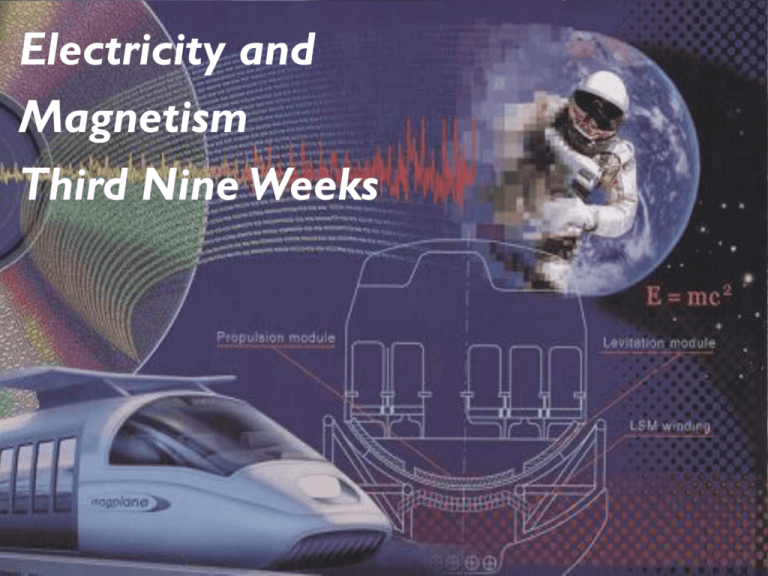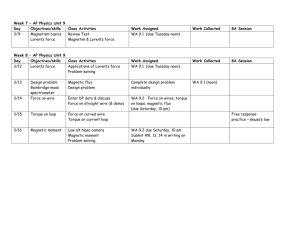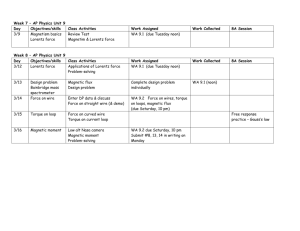3-5 Physics Elec Mag
advertisement

Electricity and Magnetism Third Nine Weeks Electricity and Magnetism 1 Properties of Magnets 2 Magnetic Properties of Materials 3 The Magnetic Field of the Earth Objectives 1. Predict the direction of the force on a moving charge or current carrying wire in a magnetic field by using the right-hand rule. 2. Explain the relationship between electric current and magnetism. 3. Describe and construct a simple electromagnet. 4. Explain the concept of commutation as it relates to an electric motor. 5. Explain how the concept of magnetic flux applies to generating electric current using Faraday’s law of induction. 6. Describe three ways to increase the current from an electric generator. 1 Electric Current and Magnetism Key Question: Can electric current create a magnet? Electric Current and Magnetism In 1819, Hans Christian Oersted, a Danish physicist and chemist, and a professor, placed a compass needle near a wire through which he could make electric current flow. When the switch was closed, the compass needle moved just as if the wire were a magnet. Electric Current and Magnetism Two wires carrying electric current exert force on each other, just like two magnets. The forces can be attractive or repulsive depending on the direction of current in both wires. Electric Current and Magnetism The magnetic field around a single wire is too small to be of much use. There are two techniques to make strong magnetic fields from current flowing in wires: 1. Many wires are bundled together, allowing the same current to create many times the magnetic field of a single wire. 2. Bundled wires are made into coils which concentrate the magnetic field in their center. Electric Current and Magnetism The most common form of electromagnetic device is a coil with many turns called a solenoid. A coil takes advantage of these two techniques (bundling wires and making bundled wires into coils) for increasing field strength. The true nature of magnetism The magnetic field of a coil is identical to the field of a disk-shaped permanent magnet. Electric Current and Magnetism The electrons moving around the nucleus carry electric charge. Moving charge makes electric current so the electrons around the nucleus create currents within an atom. These currents create the magnetic fields that determine the magnetic properties of atoms. Magnetic force on a moving charge The magnetic force on a wire is really due to force acting on moving charges in the wire. A charge moving in a magnetic field feels a force perpendicular to both the magnetic field and to the direction of motion of the charge. Electromagnets and the Electric Motor Key Question: How does a motor work? *Students read Section 23.2 AFTER Investigation 23.2 Electromagnets and the Electric Motor Electromagnets are magnets that are created when electric current flows in a coil of wire. A simple electromagnet is a coil of wire wrapped around a rod of iron or steel. Because iron is magnetic, it concentrates and amplifies the magnetic field created by the current in the coil. Electromagnets and the Electric Motor The right-hand rule: When your fingers curl in the direction of current, your thumb points toward the magnet’s north pole. The principle of the electric motor An electric motor uses electromagnets to convert electrical energy into mechanical energy. The disk is called the rotor because it can rotate. The disk will keep spinning as long as the external magnet is reversed every time the next magnet in the disk passes by. One or more stationary magnets reverse their poles to push and pull on a rotating assembly of magnets. The principle of the electric motor Commutation The process of reversing the current in the electromagnet is called commutation and the switch that makes it happen is called a commutator. Electric Motors Electric motors are very common. All types of electric motors have three key components: 1. A rotating element (rotor) with magnets. 2. A stationary magnet that surrounds the rotor. 3. A commutator that switches the electromagnets from north to south at the right place to keep the rotor spinning. Electric Motors If you take apart an electric motor that runs on batteries, the same three mechanisms are there; the difference is in the arrangement of the electromagnets and permanent magnets. Electric motors The rotating part of the motor, including the electromagnets, is called the armature. This diagram shows a small battery-powered electric motor and what it looks like inside with one end of the motor case removed. Electric motors The permanent magnets are on the outside, and they stay fixed in place. The wires from each of the three coils are attached to three metal plates (commutator) at the end of the armature. commutator Electric Motors As the rotor spins, the three plates come into contact with the positive and negative brushes. Electric current flows through the brushes into the coils. Induction and the Electric Generator Key Question: How does a generator produce electricity? Induction and the Electric Generator If you move a magnet near a coil of wire, a current will be produced. This process is called electromagnetic induction, because a moving magnet induces electric current to flow. Moving electric charge creates magnetism and conversely, changing magnetic fields also can cause electric charge to move. Induction Current is only produced if the magnet is moving because a changing magnetic field is what creates current. If the magnetic field does not change, such as when the magnet is stationary, the current is zero. Induction If the magnetic field is increasing, the induced current is in one direction. If the field is decreasing, the induced current is in the opposite direction. Generators A generator is a device that uses induction to convert mechanical energy into electrical energy. Transformers Transformers are extremely useful because they efficiently change voltage and current, while providing the same total power. The transformer uses electromagnetic induction, similar to a generator. Transformers A relationship between voltages and turns for a transformer results because the two coils have a different number of turns. Application: Trains that Float by Magnetic Levitation








